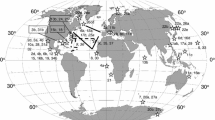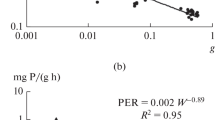Abstract
Simultaneous measurements of respiration, excretion and production rates were carried out several times over a year period at five representative stations of the Ebrié Lagoon. Assuming a constant assimilation efficiency rate of 69.4%, we derived metabolic budgets for carbon, nitrogen and phosphorus. Daily specific ingestion rates calculated were rather generally high, and ranged between 54 and 159% of body carbon, between 26 and 102% of body nitrogen and between 108 and 307% of body phosphorus. Regional and seasonal variations depended mainly upon variations in trophic conditions. Curvilinear relationships between ingestion production, or net production efficiency K2, and food concentration (as chlorophyll-a + phaeopigments) showed that food could have been a limiting factor. Furthermore, K2 were low when compared with data from the literature (mean of 21% in carbon, 39% in nitrogen and 11% in phosphorus).
Complementary laboratory experiments carried out on adults fed with enriched natural particles or algal cultures (Tetraselmis sp. or Dunaliella sp.) showed similar production (egg-production) vs food concentration curvilinear relationships as in the field. However, considerably higher maximal ingestion and production rates were obtained for animals fed algal cultures suggesting that optima for food acquisition and transformation were not reached in field conditions.
Consequently, A. clausi, which represents more than 50% of the zooplankton biomass, appears to be rather inefficient in transforming the abundant particulate organic matter produced in the lagoon. This results from its high level of metabolic expenditure through respiration or excretion (about 50% of ingestion in terms of carbon) and from the small size and poor trophic value of food particles (high percentage of detritus).
Similar content being viewed by others
References
Abou Debs, C., 1984. Carbon and nitrogen budgets of the calanoid copepod Temora stylifera: effect of concentration and composition of food. Mar. Ecol. Progr. Ser. 15: 213–223.
Antia, N. J., B. R. Berland, D. Bonin & S. Y. Maestrini, 1975. Comparative evaluation of certain inorganic sources of nitrogen for phototrophic growth marine microalgae. J. mar. biol. Ass. U.K. 55: 519–539.
Arfi, R., M. Pagano & L. Saint-Jean, 1988. Communautés zooplanctoniques dans une lagune tropicale (lagune Ebrié Côte d'Ivoire) variations spatio-temporelles. Revue Hydrobiol. Trop. 20: 21–35.
Barthel, K. G., 1983. Food uptake and growth efficiency of Eurytemora affinis (Copepodae Calanidae). Mar. Biol. 74: 269–274.
Bougis, P., 1974. Ecologie du plancton marin. II. Le zooplancton. Masson, Paris, 200 pp.
Butler, E. I., E. D. S. Corner & S. M. Marshall, 1969. On the nutrition and metabolism of zooplankton. VI. Feeding efficiency of Calanus in terms of nitrogen and phosphorus. J. mar. biol. Ass. U.K. 49: 977–1001.
Chervin, M., 1978. Assimilation of particulate organic carbon by estuarine and coastal copepods. Mar. Biol., 49: 265–275.
Conover, R. J., 1978. Transformation of organic matter. In O. Kinne (ed.), Marine Ecology. IV Dynamics, Wiley & Sons, London: 221–499.
Costello, J, 1991. Complete carbon and nitrogen budgets for the hydromedusa Cladonema californicum (Anthomedusa: Cladonemidae). Mar. Biol. 108: 119–128.
Cushing, D. H., 1973. Production in the Indian Ocean and transfer from primary to secondary level. In B. Zeitzschel (ed.), The biology of the Indian Ocean. Springer-Verlag, Berlin: 475–486.
Dagg, M. J., 1976. Complets carbon and nitrogen budgets for the carnivorous amphipod Callipus laeviusculus (Kroyer). Int. Revue ges. Hydrobiol. 61: 297–357.
Deason, E. E., 1980. Grazing of Acartia hudsonica (A. clausi) on Skeletonema costatum in Narragansett Bay (USA). Influence of food concentration and temperature. Mar. Biol. 60: 101–1114.
Dufour, P., 1984. Production primaire d'une lagune tropicale (Ebrié, Côte d'Ivoire). Facteurs naturels et anthropiques. Thèse d'Etat, Univ. Paris VI, tome 1, 166 pp.
Durand, J. R. & M. Skubisch, 1982. Les lagunes ivoiriennes. Aquaculture 27: 211–250.
Durbin, E. G., A. G. Durbin, T. J. Smayda & P. G. Verity, 1983. Food limitation of production by adult Acartia tonsa in Narragansett Bay, Rhode Island. Limnol. Oceanogr. 28: 1199–1213.
Gaudy, R., 1974. Feeding four species of pelagic copepods under experimental conditions. Mar. Biol. 25: 125–141.
Gaudy, R., 1989. The role of zooplankton in the nitrogen cycle of a Mediterranean brackish lagoon. In J. D. Ros (ed.), Topics in marine biology. Scient. Mar. 53: 609–616.
Gaudy, R. & M. Pagano, 1987. Biologie d'un copepode des mares temporaires du littoral méditerranéen français: Eurytemora velox. III. Reproduction. Mar. Biol. 94: 335–345.
Gerber, R. P. & M. B. Gerber, 1979. Ingestion of natural particulate organic matter and subsequent assimilation, respiration and growth by tropical lagoon zooplankton. Mar. Biol. 52: 33–43.
Houde, S. E. & M. R. Roman, 1987. Effects of food quality on the functional ingestion response of the copepod Acartia tonsa. Mar. Ecol. Progr. Ser. 40: 69–77.
Ketchum, B. H., 1962. Regeneration of nutrients by zooplankton. Rapp. P.v. Réun. Cons. perm. int. Explor. Mer 153: 142–147.
Kiørboe, T., F. Mohlenberg & K. Hamburger, 1985. Bioenergetics of the planktonic copepod Acartia tonsa: relation between feeding, egg production and respiration, and the composition of specific dynamic action. Mar. Ecol. Progr. Ser. 26: 85–97.
Lamotte, M., 1972. Bilans énergétiques et productions a l'échelle des individus et a l'échelle des populations. Ann. Soc. r. Zool. Belgique 103: 21–36.
Le Borgne, R., 1978. Evaluation de la production secondaire planctonique en milieu océanique par la méthode des rapports C/N/P. Oceanologica acta 1: 107–118.
Le Borgne, R., 1986. The release of soluble end products of metabolism. In E. D. S. Corner & S. C. M. O'Hara (eds), The biological chemistry of Marine copepods, Oxford Univ. Press: 109–164.
Le Borgne, R. & P. Dufour, 1979. Premiers résultats sur l'excrétion et la production du mesozooplancton de la Lagune Ebrié (Côte d'Ivoire). Doc. Scien. Centr. Rech. Oceanogr. Abidjan 10: 1–39.
Le Borgne, R., J. Blanchot & L. Charpy, 1989. Zooplankton of Tikehau atool (Tuamoto archipelago) and its relationship to particulate matter. Mar. Biol. 102: 341–353.
Nival, P. & S. Nival, 1976. Particle retention efficiencies of a herbivorus copepod Acartia clausi (adult and copepodite stages): Effect of grazing. Limnol. Oceanogr. 21: 24–38.
O'Connors, H. B., D. C. Biggs & D. V. Ninivaggi, 1980. Particle size dependent maximum grazing rates for Temora longicornis fed natural particle assemblages. Mar. Biol. 56: 65–70.
Paffenhöfer, G. A., 1976. Feeding, growth and food conversion of the marine planktonic copepod Calanus helgolandicus. Limnol. Oceanogr. 21: 39–50.
Paffenhöfer, G. A., 1988. Feeding rates and behavior of zooplankton. Bull. Mar. Sci. 43: 430–445.
Pagano, M. & L. Saint-Jean, 1985. Premières données sur la nutrition d'Acartia clausi en lagune Ebrié (Côte d'Ivoire) obtenues par des mesures de fluorescence de broyats d'animaux. Hydrobiologia 121: 83–95.
Pagano, M. & L. Saint-Jean, 1988. Importance et role du zooplancton dans une lagune tropicale, la lagune Ebriè (Côte d'Ivoire): Peuplements, biomasse, production et bilan métabolique. Thèse Doct. Etat, Univ. Aix-Marseille II 390 PP, annexe 50 pp.
Pagano, M. & L. Saint-Jean, 1989. Biomass and production of the calanoid copepod Acartia clausi in a tropical coastal lagoon: Lagune Ebriè, Ivory Coast. In J. D. Ros (ed.), Topics in marine biology. Scient. Mar. 53: 617–624.
Pagano, M. & L. Saint-Jean, in press. Le zooplancton. In P. Dufour, J. R. Durand & G. Zabi (eds), Synthèses sur les lagunes ivoiriennes.
Pagano, M. & L. Saint-Jean, 1993. Organic matter, carbon, nitrogen and phosphorus content of the mesozooplankton, mainly Acartia clausi, in a tropical brackish lagoon (Ebrie Lagoon, Ivory Coast). Int. Revue ges. Hydrobiol. 78: 143–153.
Petipa, T. S., A. V. Monakov, Y. I. Sorokin, G. V. Voloshina & I. V. Kukina, 1977. Balance of matter and energy in tropical upwellings of Pacific ocean. Pol. Arch. Hydrobiol. 24: 413–430.
Pourriot, R. & P. Champ, 1982. Consomateurs et producteurs secondaires. In R. Pourriot, J. Caplancq, P. Champ & J. A. Meyer, Ecologic du plancton des eaux continentales. Masson, Paris: 49–122.
Razouls, S. & M. Apostolopoulou, 1977. Bilan énergétique de deux populations de copépodes pélagiques Temora stylifera et Centropages typicus en relation avec la présence d'une thermocline. Vie Milieu 27: 13–15.
Richman, S., 1958. The transformation of energy by Daphnia pulex. Ecol. Monogr. 28: 273–291.
Saint-Jean, L. & M. Pagano, 1984. Influence de la salinité, de la temperature et de la quantité de particules en suspension sur la croissance et la production d'oeufs d'Acartia clausi en lagune Ebrie (Côte d'Ivoire). Revue Hydrobiol. trop. 17: 235–244.
Saint-Jean, L. & M. Pagano, 1987. Taille et poids individuels des principaux taxons du zooplancton lagunaire ivoirien: lagune Ebriè; étangs de pisciculture saumâtres de Layo. Revue Hydrobiol. trop. 20: 13–20.
Verity, P. G., 1985. Grazing, respiration, excretion and growth rates of tintinnids. Limnol. Oceanogr. 30: 1268–1282.
Vidal, J., 1980. Physioecology of zooplankton. IV. Effects of phytoplankton concentration, temperature, and body size on the production efficiency of Calanus pacificus. Mar. Biol. 56: 195–202.
Vidal, J. & T. E. Whiteledge, 1982. Rates of metabolism of planktonic crustaceans as related to body weight and temperature. J. Plankton Res. 4: 77–84.
Zaika, V. E., 1970. Age-structure dependence of the ‘specific production’ in zooplankton population. Mar. Biol. 1: 311–315.
Author information
Authors and Affiliations
Rights and permissions
About this article
Cite this article
Pagano, M., Saint-Jean, L. In situ metabolic budget for the calanoid copepod Acartia clausi in a tropical brackish water lagoon (Ebrié Lagoon, Ivory Coast). Hydrobiologia 272, 147–161 (1994). https://doi.org/10.1007/BF00006518
Issue Date:
DOI: https://doi.org/10.1007/BF00006518




